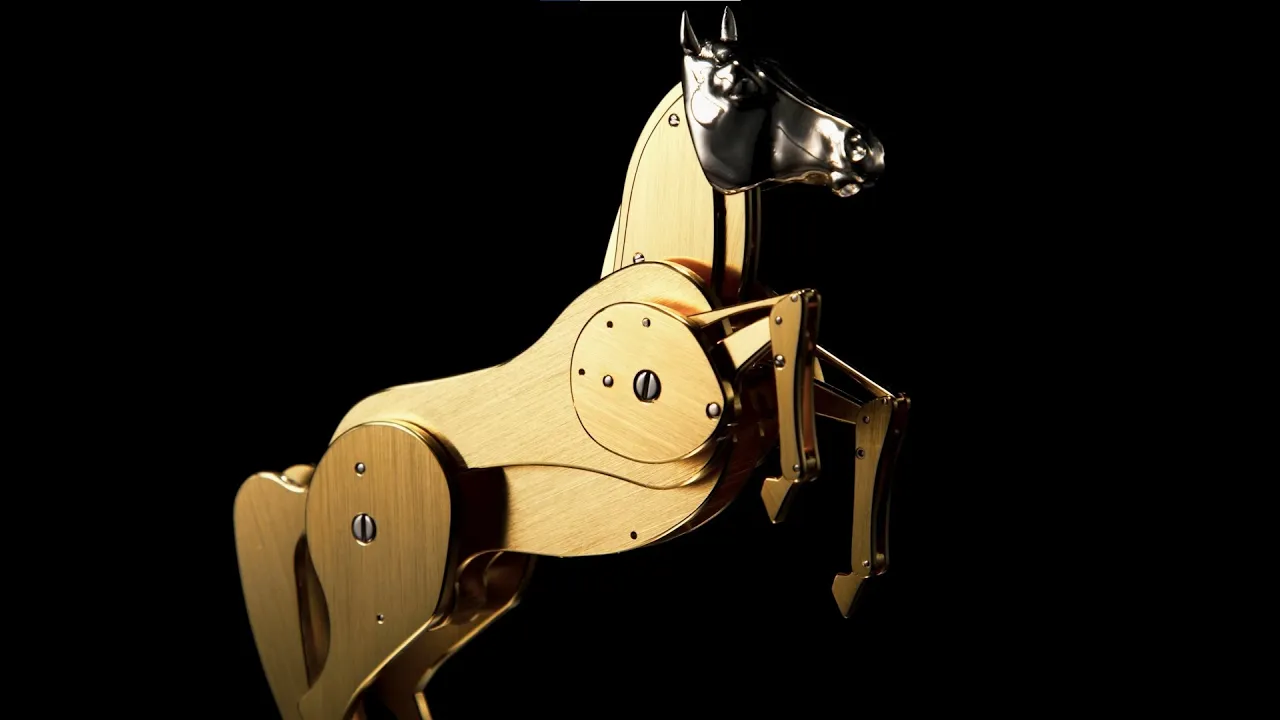Fascinating humanity through the ages as its most trusty companion and noblest conquest, the horse can be said to have reached the status of a living mythical animal. Horses have been at humanity’s side all through history, their silhouettes decorating the earliest cave paintings, their pace giving rhythm to the everyday life of thousands of thoroughbred connoisseurs. Artists have always been challenged by the mechanical reproduction of their mighty stride. Rearing, in particular, has always eluded automaton-makers. Until now – “Le Cabré” by John-Mikaël Flaux.

Are there any limits to human-made mechanical creation? One might be inclined to think so. Our own inventions, from cars to spaceships, are always being perfected, polished, up to the point where they seem to take on an intelligence of their own. But it takes an outstanding amount of talent to reproduce a movement that we did not create: to emulate nature, with all its subtleties.

A legacy of the Age of Enlightenment
Songbirds were always a favorite with automaton-makers. Since the Age of Enlightenment, skilled artisans have faithfully rendered their movements and songs. But the horse is a whole new level of difficulty. Combining force with grace, power, and agility, the kinematics of trot and gallop summon up hundreds of muscles and movements synchronized in perfect harmony and fluidity. The association of perfect stability on the hind legs with an asynchronous mobility of the two forelegs required for the rearing position makes its mechanical reproduction a technical feat.

But technical achievement in itself is nothing without emotion. Handmade automatons possess their own element of poetry, a personal touch that differentiates them from robots. In a way, they hold a part of their creator’s soul. By expressing the essence of movement, they aim at provoking the senses of their spectator. By creating his Rearing Horse, John-Mikaël Flaux rose to the challenge.

A personal challenge
John-Mikaël Flaux has been designing and handcrafting automatons for over ten years. A watchmaking graduate, who was awarded a gold medal at the French Best Apprentice competition, he opened his own workshop in 2008. In 2012, he was recruited by the Swiss brand Ulysse Nardin as a designer. He became an independent designer and watchmaker in 2018 and settled in France where he creates exceptional automatons – the Duel, the Car Clock and the Cheetah being among the most notable.

The vision of a rearing horse came to him in 2019. His imagination was completely taken over by the conception of this perfectly fluid and purely mechanical creation. The challenges were many and immense. First, reproducing the physiognomy of an Arabian thoroughbred. Connoisseurs should be able to recognize it at first glance: a fine face, slender muscles, and a high, curved tail – exuding velocity, without losing any of its elegance.

Hidden sophistication
Next came the mechanical conception. John-Mikaël Flaux’s Rearing Horse hides several automatons blended into one: each part has its own, dissociated movement – the body, the left and right front legs, the mane, and the head. All pieces work together in perfect gestural harmony, without the slightest jolt – as would be the case with automatons of a lesser craftsmanship.

Knowing full well that real connoisseurs can automatically pick up the slightest mechanical defect, John-Mikaël Flaux worked with several horse riders who helped him perfect primary versions of the Rearing Horse and reject the ones that didn’t work, by pointing out movements that seemed unnatural, exaggerated, too slow or fast. For months on end, our craftsman continually raised the bar and jumped over each hurdle. Another challenge resided in getting the acoustics of the piece right. John-Mikaël Flaux designed an engine capable of activating the Rearing Horse in complete and utter silence.

Moving poetry
Last but not least, there is this imperceptible element of poetry that John-Mikaël Flaux breathed into each movement of the Rearing Horse, until the animal truly took on a life of its own. This translates into the fluid movements of its legs, mane, and head, as well as into its delicate finishing touches.

John-Mikaël used all the finishing techniques available in clockmaking – chamfering, satin finish, and polishing. All chamfers are done by hand. In this, the Rearing Horse also conveys the prestigious, age-old expertise of the city of Besançon, where its creator lives. This French city’s craftsmanship of mechanical watchmaking and art mechanics was recently inscribed into UNESCO’s representative List of the Intangible Cultural Heritage of Humanity.

As alluring as the challenge might be, the goal wasn’t just to make a true-to-life copy of nature. “My Rearing Horse has nothing to do with machines, artificial intelligence or robots”, John-Mikaël Flaux explains. “It was entirely drawn by hand. I personally made 75% of its components in my own workshop, and trusted specialized artisans with the rest, such as the wooden case. The mechanism needs to be winded by hand. In this Rearing Horse, there is as much passion as there is intent and poetry. This spiritual complement sets each piece apart and creates a strong connection with each collector”.

Bespoke items only
Each Rearing Horse will be unique and made to order with bespoke modifications. Different materials, finishing touches, and colors are available; the case can also be modified to order, as well as the clock it can include. The Rearing Horse is an unrivaled creation, a masterpiece of fluidity and nature, equaled only by its complexity and ingenuity. Each piece is individually signed by John-Mikaël Flaux and can be ordered through Ben&Bros.

“Le Cabré” by John-Mikaël Flaux Technical Specifications
- 450 componants
- 1500 h manufacturing
- 2 years of creations * L.224 * l.124 * H.240
- Rearing horse only: L.100 * l.25 * H.130
- 100% mechanical – key winding –
- Mysterious trigger with clock (Ø47)
- Materials: Golden brass, polished steel
- Solid silver head
- Smoked eucalyptus box
- Full-grain Taurus and Alcantara leather trunk
- Glass showcase
“Le Cabré” by John-Mikaël Flaux Gallery


























